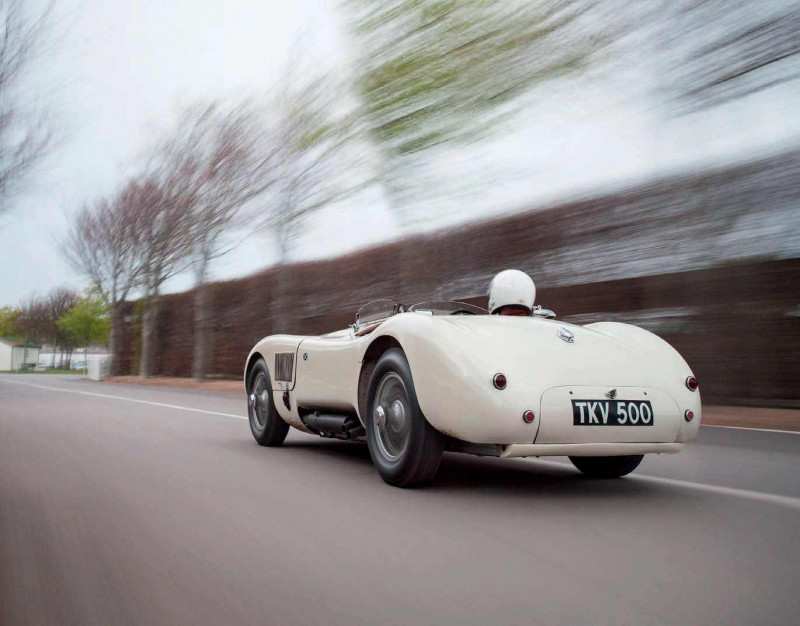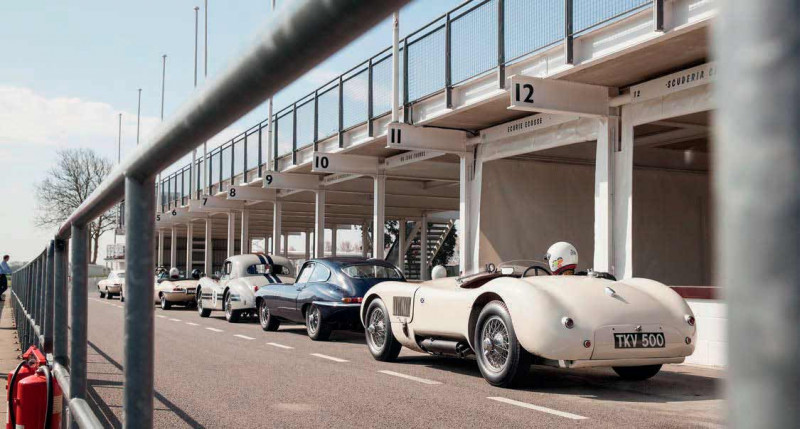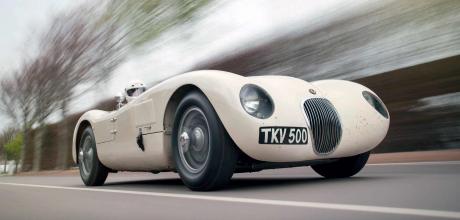1951 Jaguar C-Type Goodwood track test
Our new editor relives his memorable experience behind the wheel of a storied C-type at this iconic racetrack. Words: Ray Ingman. Photography: Kelsey Archive.
ON TRACK AT GOODWOOD
CELEBRATING A RACING LEGEND AT GOODWOOD AND SAMPLING A REPLICA ON THE ROAD
C TYPE AT 70
We experience an iconic car at an iconic venue and discover what it’s really like to get behind the wheel
Owners of historic cars tend to fall into two factions: those who regard their possessions as museumpiece investments and individuals who consider that their tenure of ownership should advance the history of the car, providing maximum enjoyment along the way. Within a few moments of making Dr Hans-Martin Schneeberger’s acquaintance in a sunny Goodwood paddock, it is obvious that he falls heavily into the latter and (in my biased view) rather more enlightened group. The CKL Developments pre-pandemic track day we found ourselves attending marked Hans-Martin’s maiden flight in his latest acquisition, the C-type Jaguar better known by its chassis number XKC015. So what was the path that led him to this day?

THE OWNER
Hans-Martin was born into a Swiss family that considered cars to be a means of transport rather than objects of desire. However, they did own an engineering company that, under his control, has developed into a leading international supplier of high-end bearing products. He is now the CEO of Schneeberger Linear Technology, a role that funds his passion, a condition whose genesis was rooted in the purchase of his first car, an Austin- Healey Sprite MkII. This car was secured in 1973 for the sum of 600 Swiss francs, a figure that appreciated to 900 CHF after three years and a lot of fun. The money was then invested in a VW Beetle and a scrap Porsche 356, with Hans-Martin applying his engineering skills to unite the pair into a rather fast saloon car. With the benefit of hindsight, he admits that this may not have been the most financially astute move he has ever made! However, the entertainment it provided sowed a seed that finally germinated a decade ago at an event known as the Klausen Pass Memorial hillclimb – a 21.5km competition for pre-war cars held on what is widely regarded to be among the top ten driving roads in Europe, located south of Zurich in the heart of the Alps.
The experience of spectating at the event triggered the purchase of an MG K3 Replica, and consequently the beginning of his competition career. The term ‘replica’ rankled slightly and led to the desire for an example of the ‘real thing’. This yearning was satisfied by the procurement of an SS100 in totally original condition with a verified history; more hillclimb action followed supplemented by forays into other iconic events such as the Mille Miglia.

The sheer elegance of the SS100 seeped into Hans-Martin’s soul, so when the desire to secure a car more suited to long distance road rallies evolved, it simply had to be another Jaguar. To Hans-Martin, the only flaw in his SS100’s otherwise immaculate specification was a perceived lack of period racing history. Utilising his analytical engineer’s mind, he fully researched the subject of genuine period competition cars and discovered that in 1950, Jaguar built six ‘works’ aluminium-bodied XK120s (chassis numbers 660040 to 660044 and 660057). These cars enabled a publicity-driven limited competition programme to be undertaken by favoured private entrants. The acquisition of this information confirmed his resolve that his next Jaguar would be one of this elite band – the only impediment being the rarity of these models actually coming to the market place.
LE MANS XK120
His patience and ambition were rewarded in 2009 when this extraordinary ambition became a reality. Specialist car dealer Fiskens was consigned 660041 and announced that it was to be displayed on its stand at the Paris Retromobile show. This car was originally sold to L.H. ‘Nick’ Haines, who promptly employed it to contest the 1950 Mille Miglia, unfortunately crashing out 200 miles shy of the finish line. Later in the same year, with the driving shared with Peter Clark, it achieved 12th place in the Le Mans 24hr race, conferring upon it the honour of being the first Jaguar ‘home’. This was the sort of history Hans-Martin wanted to buy into, and then further enhance with his own exploits. Therefore, Dr Schneeberger ensured he was first in the queue when the show opened its doors. A deal was swiftly concluded, contingent on the satisfactory verification of its provenance.

A mutual friend introduced him to Chris Keith-Lucas and, within 15 minutes of meeting, the pair ‘hit it off’, with reciprocal respect and shared values underpinning their new relationship.
Chris confirmed its authenticity and upon completion of purchase, the car was immediately repatriated to England, heading for the premises of CKL Developments in the historic town of Battle, East Sussex. A comprehensive recommissioning process followed, these two consecutive events marking the start of a long-term business and personal relationship. The competition 120 has since continued its career in the capable hands of the new owner, adding four Mille Miglias and two Le Mans Classics to its tally.
There is a case to suggest that 660041 played a major role in convincing Sir William Lyons of the commercial viability in building the C-type, and so the next natural Jaguar progression for Hans-Martin to target was an example of that model. Again, verifiable period competition history was a must, along with a timeline that bore no question marks as to its authenticity.
XKC 015 PROVENANCE
Whilst XKC 015 is always referred to as the Masten Gregory car, he was actually the second owner of the second C-type exported to the USA. West Coast importers Hornburg originally sold it to one J. Hall, who proceeded to race it but once. Hence, when Mr Gregory purchased it from him, it was a secondhand, albeit little-used race car. Its early racing history is intriguingly recorded by the engraving on the fuel filler cap; it documents his first win in the car at San Francisco’s Golden Gate Park, but fails to mention their final event together.
At Floyd Bennett Field, Brooklyn, he spun off and made heavy contact with an oil drum, the impact splitting the C’s fuel tank and resulting in a fairly serious conflagration. Masten, however, was not present at that point; he had executed his signature move and leapt out, ending up far enough from the scene of the accident to suffer only mild singeing of body hair. His state of health was such that he sprinted back to the pits and immediately purchased another C-type (XKC 022) from a competitor in order that he could complete the meeting!
Just prior to this relationship-terminating incident, Masten generously lent the car to the prestigious Road and Track magazine, which had been unable to secure a C-type for road testing and was anxious to experience an example on behalf of its readership. The resulting report was suitably glowing, whilst achieving the “best set of acceleration figures” the magazine had ever encountered”.
The damaged 015 was then purchased by Sherwood Johnson, who rebuilt it as far as a rolling chassis. In this state, sans bodywork, he entered and won the 1954 Mount Washington hillclimb. The body was subsequently restored in a rather shoddy fashion, and in that state the car passed between several documented owners who employed it largely for road use over the next decade. Salvation came in the shape of Mark Daniels, who purchased 015 in 1964. In a parallel with Hans-Martin’s later Porsche 356 activity, he also purchased another C (034) to break for spare parts – the sum of $900 being required to secure the latter V8 re-engined vehicle.
His detailed restoration back to total originality laid the foundations for the car we see today. Twenty years after its original test, Road and Track marked the restoration’s completion by revisiting the car – and, of course, the testers were still impressed. Fast-forwarding, Daniels parted with the car in 1979 after 15 years of ownership. Pausing briefly in Canada, it then returned to home soil and spent the years between 1984 and 2008 in the possession of arch enthusiast Tom Candish. During his tenure, 40,000 miles were added to the odometer’s total – surely a C-type driving record? A period ‘around the trade’ ended when Hans-Martin walked through the door of Duncan Hamilton’s Hampshire showroom. In a repeat of his XK120 purchasing experience, he again engaged Chris Keith-Lucas to first scrutinise the car and then oversee its total recommissioning. No detail was taken for granted or left unchecked, but both Hans-Martin and Chris were in total accord that no work should be done that would compromise the car’s hard-won patina of originality.
ACCOMPANYING HANS-MARTIN
Very few are afforded the opportunity to drive such a vehicle, so I feel it’s my duty to attempt to convey what the experience presents relative to the C-type’s modern descendants. It seemed a good plan to first familiarise myself with the car in the hands of its owner. In the paddock, having only previously driven replica Cs, I commit what might be termed a schoolboy error. To board the passenger side, I absent-mindedly reach down for the internal leather strap that releases the latch for the door that the car is not fitted with! Swiftly glossing over my fundamental oversight, I carefully step in over the side, having placed a steadying hand on the sturdy rear deck whilst positioning my foot carefully onto the exposed tubular chassis crossmember, thence sliding down into the cloth-trimmed bucket seat.
By standards of the time, these seats were considered to be supportive – but Recaro’s involvement in automotive seating was over a decade away, and all things are relative. Modern perspective gives the impression of sitting slightly on the car as opposed to in it.
Setting off unimpeded by the donning of a seatbelt now seems decidedly unnatural, and spirited driving finds this passenger involuntarily bracing against the forces generated. Over the years, this vehicle has obviously been somewhat detuned from ultimate track use in favour of a more road-friendly set up, with softly-set dampers allowing quite marked roll angles to be achieved very early into the cornering phase of proceedings. The overriding impression gleaned for the passenger seat is of a surprisingly smooth and docile car, but one with a superb soundtrack courtesy of the side-mounted exhaust system.
The period-specification Goodwood circuit always seems to be the most apposite environment to sample a period-specification racing car. The circuit is devoid of modern accoutrements such as Armco barriers and gravel traps (to be strictly accurate, save one minor stony aberration at Lavant corner) and matches a competition car bereft of a roll hoop and – rather more obviously – the aforementioned harnesses. Lunch intervenes, following which Hans-Martin has to return to Switzerland, leaving me in custody and control of his prized possession. His parting instruction was: “Enjoy… and try to keep it on the black bit”.
BEHIND THE WHEEL
I’m privileged to be sitting behind the steering wheel of one of the more patinated, continuous-history C-types extant. Now conservatively valued at around £5 million, a ‘biggy’ would thus equate to around two months’ remuneration from my CJ editorial income… My concern is not without precedent. Goodwood has a little Jaguar ‘history’ in this regard, with the 2008 Festival of Speed seeing the bronze, Stirling Moss record-breaking XK120 (LWK 707) damaged. Two years later, 77 RW – the ex-Geneva E-type roadster – was similarly afflicted. The latter had been refurbished from a total basket case but the former was in virtual time-warp condition, having been retired into a display role shortly after its historic exploit.
Although unthinkable, a minor transgression in the C-type I’m about to drive would result in a diminution of the car’s intrinsic originality. CKL has developed a bespoke throttle pedal to suit the owner’s personal driving style, but unfortunately it doesn’t suit mine and I have to be very mindful not to operate the accelerator and brake simultaneously – possibly instigating just the type of incident I was determined to avoid! The single most impressive feature of the car is the steering, a rack and pinion system unsullied by any form of power assistance. It is so light and precise, affording almost telepathic feedback, that it seems to have gone back in time from a far more recent era. The C-type’s drum brakes demand a positive shove to instigate retardation, but once warm their efficiency and progression is impressive. Belief has to be suspended against perceived deficiencies addressed by the introduction of the much-heralded disc brake later in the production run.
DRIVER INVOLVEMENT
In my estimation, anybody with a basic modicum of driving talent could pilot this C-type at brisk road speeds. Behind the wheel, it proves to be docile and forgiving with no notable vices. Many modern motorists fear the three-synchro Moss gearbox, most commonly experienced in the pre- 1967 saloons; this car is fitted with one of the very best examples and, whilst it would be fatuous to claim the synchronisation is unbeatable, it requires the very minimum of time-related consideration to achieve clean, satisfying ratio changes. The power is fed in via a progressive, well-weighted clutch pedal and a similarly-endowed throttle linkage.
The driver input required when the pace is increased, however, is quite physical. The most generally accessible parallel I can liken this to is karting: upper body strength is required to support one’s torso, leaving your arms free to conduct the serious business of steering. With no electronic driver aids, you know that the car – for better, for worse – is reacting solely to your input. The last Jaguar I’d driven around Goodwood immediately prior to the C was a rear-wheel drive F-TYPE V8, a sublime driving experience – but it did lead you to question how much of it was actually the car’s ability rather than that of the driver.
With a little more familiarity of the C-type, I learn that the most effective way to progress around the circuit at a respectable speed is to deliberately turn in late to a corner, loading up the front end and then addressing any discrepancy in intended trajectory by application and modulation of the throttle rather than continued variation of steering input. I decided it inappropriate to indulge in any extreme opposite-lock antics; the good Doctor had been kind enough to entrust me with his prized possession, and I was not about to abuse that privilege. In summary, driving this car, even in comparison with the standards of today, proves how far ahead of its time it must have been in the early 1950s. This was indeed a very special experience.
POSTSCRIPT
Subsequent to our track test, Hans- Martin and 015 participated at the Villa d‘Este Concorso d’Eleganza event, the Monaco Historic GP and the Mille Miglia. He entered Classic Le Mans in 2020, but this was postponed… first to 2021 and now to 2022. The good Doctor is certainly advancing the car’s history under his ownership.
THANK YOU We’re grateful to Dr Hans-Martin Schneeberger and CKL Developments (tel 01424 870600, www.ckldevelopments. co.uk ) for their help with this feature and our on-track experience.
“...upper body strength is required to support one’s torso, leaving your arms free to conduct the serious business of steering”
“...this vehicle has obviously been somewhat detuned from ultimate track use in favour of a more road-friendly set up”
MASTEN GREGORY
Although not exactly a forgotten hero, Masten Gregory carved out a niche in motor racing history, largely founded on his early exploits in XKC 015. Born in Kansas City, Missouri, in 1932, his career encompassed inclusion in the exclusive 19 member club, whose admission requirement is to enter in all three events that comprise the ‘Triple Crown’ of motor racing, winning at least one. These were the Indy500, Le Mans and the Monaco Grand Prix. As an aside, regular Mk2 and E-type pilot Graham Hill is the only driver ever to win all three.
Perhaps Gregory’s greatest claim to fame was an outright win in the 1965 Le Mans 24-hour race (a year devoid of Jaguar entries) at the wheel of a Ferrari 275LM, thus ensuring his entry into the club. The pinnacle of motorsport, Formula 1, was contested between 1957 and 1965, but despite a podium in his first Grand Prix, no outright wins resulted. A rather less tangible accolade was bestowed upon him by two-time Scottish F1 champion Jim Clark, who considered him ‘his hero’.
He retired from racing in 1972 following the death of his friend, Swedish driver Jo Bonnier, at Le Mans. Whatever else he achieved in his 20 year racing career, Gregory’s most lasting memorial has proved to be his signature move: the ‘bail out’. When Masten felt that a crash was inevitable, he reasoned the best place to be was not in the car, so would leap out at the last possible moment. Although this scheme resulted in various periods of injury, premature death was avoided. Actual death occurred in 1985, peacefully of a heart attack in his sleep at the tender age of 53.
“...he sprinted back to the pits and immediately purchased another C-type (XKC 022) from a competitor”
C-TYPE CAREER
For further reading on the full history of the C-type, we recommend Richard Gunn’s in-depth feature published in the Autumn 2020 issue of Classic Jaguar. To order a copy and have it delivered anywhere in the world, check out our Back Issues advert on page.


